Thanks to Amtrak for providing the train travel portion of this adventure through Boston, Philadelphia, New York, and Washington, DC! As always, all opinions are our own.

In honor of National Train Day, we have joined with Amtrak to explore America’s great founding cities, Boston, Philadelphia, New York, and Washington, DC.
Obviously, we couldn’t possibly see all these in one day, so we will be stretching things out into a national train week… plus a day or two.
Day One: Boston

The train is the perfect transportation choice for our endeavor, since we will arrive right in the heart of each city at some of our country’s most impressive and iconic terminals, beginning with Boston’s South Station.
Morning: It All Starts with a Tea Party (or Having our Morning Tea)

Most of Beantown’s famous colonial sites are within an easy walk from the station, or they can be reached on the “T” in just a few stops. Just grab a Charlie Ticket and go. Perhaps we should explain, Charlie has been famous to Bostonians ever since the Kingston Trio sang about him as “the man who never returned” from the old MTA transit system back in 1959 and now the electronic fare cards bear his name.

We begin with the Boston Tea Party Museum, which is just across the bridge from South Station.
Replica ships wait in the harbor for new groups of patriots to board, but first we sit in on a meeting of The Sons of Liberty that led to the famous protest back in 1773.
After our rowdy “Hizzahs!”, our mob scrambles to the ships where we throw bales of tea in to the harbor. Yup, true story.



One of the events that led to the tea uprising, The Boston Massacre, took place a few years earlier, in 1770, at The Old State House.
We stand on the very spot where tensions ran high — and finally snapped — when British soldiers shot into a crowd of colonists, killing five men and injuring six others.


The incident became a rallying cry for those who wished to throw off the yoke of British rule.
Nearby, The Old South Meeting House stands just as it did on that fateful night of December 16, 1773, when thousands of fed up Bostonians gathered and decided to stage a history changing protest.
They called it The Destruction of the Tea, but we know it better as the Boston Tea Party.
Afternoon: Freedom Trail – ho!


As we follow the Boston Freedom Trail, we arrive at the Old Granary Burial Ground, the city’s third-oldest cemetery, dating back to 1660.
This is the final resting place for many patriots, including Paul Revere, John Hancock, Samuel Adams, and the five victims of the Boston Massacre.

Evening: The Cradle of Liberty and Real Yankee Food
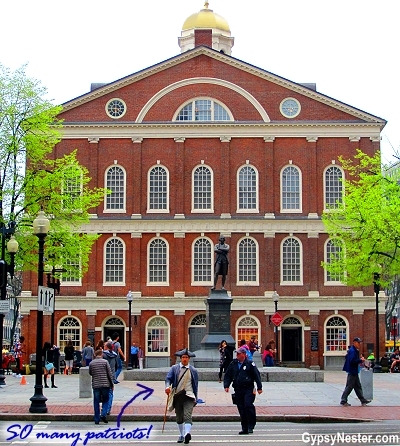
Stopping in at Faneuil Hall has been an everyday event in Boston since 1742, so naturally we make our way there.
Serving as both a marketplace and a meeting hall, it was the venue for rousing speeches encouraging independence from Great Britain – earning it the nickname “Cradle of Liberty”.

In 1826 the marketplace was expanded creating Quincy Market, as more and more people came to this crossroads of the city.
The markets have featured food since they opened, and Durgin-Park is the oldest existing restaurant in Faneuil Hall Marketplace, so that’s the place for us.
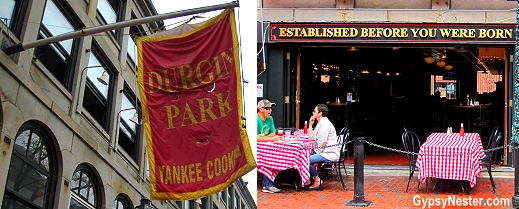
Durgin-Park opened in 1826, but the location has been feeding Bostonians all the way back to 1742. They still serve up classic Yankee fare, so pot roast and a lobster roll is dinner — with a Sam Adams beer to wash it down — it would be unpatriotic otherwise.

Day Two: Boston
Morning: Heading North

The North End of Boston has many of the city’s most famous landmarks, including the Old North Church.
Built in 1723, this is where Paul Revere sent the “One if by land, and two if by sea” signal across the Charles River.
Still an active church, the interior has kept the old box pews that were common in colonial times. Families paid an annual fee for their private boxes.


Nowadays, people sit anywhere they choose.
Paul Revere lived near the church and his house, built around 1680, is still standing.
It is the oldest house in downtown Boston, with an astounding ninety percent of the building being the original materials.
The furnishings are believed to have belonged to the family, and several fine examples of Revere’s silversmith work are on display too, including one of his famous bells.
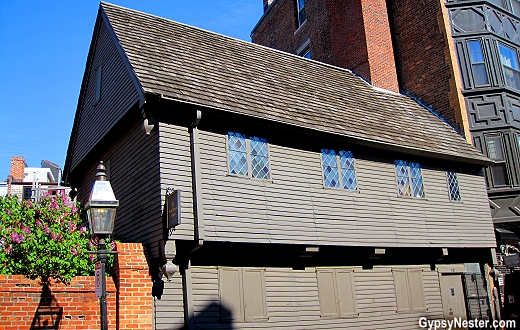
Afternoon: Battling Bunker Hill

The town of Charleston stands across the Charles River and is best known for being the starting point of Paul Revere’s ride after the signal from the North Church, and also as the site of the Battle of Bunker Hill a few months later.
The battle for control of the hill on June 17, 1775 was the first major conflict of the Revolutionary War.
The Bunker Hill Monument commemorates that battle, but actually stands atop Breed’s Hill, which was where most of the fighting took place.
Evening: Ready for Our Overnight to DC!
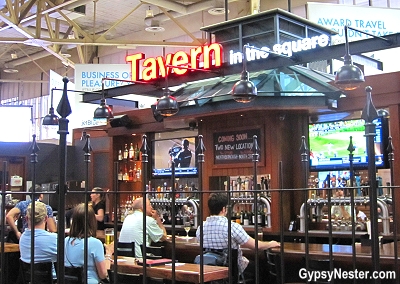
Leaving Boston to make our way to the nation’s capital is just as easy as arriving was, because South Station is so close to all of the city’s downtown attractions.
We stop for one last look of the skyline, step inside and watch a few minutes of the Bruins playoff game (wicked good), then off we go for our overnight journey to Washington, DC.

Day Three: Washington DC
Morning: Coffee, Union Station and a glimpse of the Capitol


After a couple of cups of coffee from the café car, we arrive bright and early in our nation’s capital. Union Station in Washington, DC is the most impressive depot we have ever traveled through.
From the bright shopping area around the gates, to the amazing, massive main hall almost one hundred feet high, the station leaves our jaws dropping.
See more of DC’s incredible Union Station!

Opened in 1907, this grand old terminal was the largest in the world and has seen many kings, queens, and, of course, presidents pass through.
Back in the pre-Air Force One days, seventeen presidents from Taft to Eisenhower used a private suite added in 1909. More surprising were the mortuary, bowling alley, YMCA, and Turkish baths that were also on the premises.

The Capitol Dome highlights the view as we walk out the front doors, and instantly we know we are in a city like no other in America.
Or anywhere else for that matter.
We can’t wait to get out and explore The Mall!
See more of DC’s incredible Union Station!
Afternoon: Headed to The Mall

Just outside the station, there are bikes for rent — what a great idea!
The main attractions of Washington are spread out over several miles, so walking could take up most of our time.
Pedaling along the extremely bike-friendly paths through the mall area solves time issues and prevents mighty tired tootsies by the end of the day.

If any one of the dozens of iconic buildings and monuments in the District of Colombia can symbolize the city — perhaps the entire country — it must be the Capitol.
President George Washington laid the cornerstone on September 18, 1793 and the first session with both houses of congress was held in November of 1800.

The construction was nowhere near finished at that time, but our government had a home. In fact, construction continued for well over a century and most of the time as a work in progress.
From our first vantage point in front of the east steps, we can easily see the difference in stone between the original structure and the expansion that began in 1850.

That expansion led to the most recognizable feature being added, the dome. The expanded capitol was so large that the original dome looked pretty puny, so in 1855 a fitting cupola was created. We most certainly applaud the decision as a capital idea, it just wouldn’t be the same without it.
Off in the distance we can see the Washington Monument, and beyond that, nearly two miles away, the Lincoln Memorial.
Time to get pedaling!
See more about The National Mall of DC
Evening: The Enormity of it All – and the White House
Before we set out to see the monuments, we head over to the most famous residence in town, 1600 Pennsylvania Avenue. Built from 1792 to 1800, the house wasn’t finished in time for George Washington to move in, but every president since has lived here.

Like the Capitol, The White House has been a work in progress, with numerous additions and renovations, and both were burned by the British in 1814, during the war of 1812. James and Dolley Madison were forced to move out but repairs began immediately, so by 1817 the new president, James Monroe, moved in. That kept the streak alive.
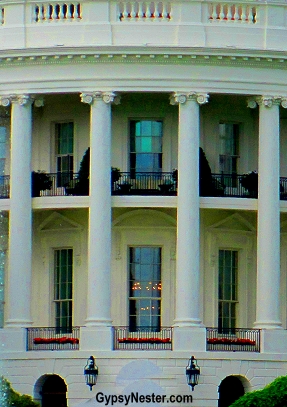
At first no one was sure what to call it, the President’s Palace, the President’s House, or the Executive Mansion. Over time people dubbed it The White House, and in 1901 President Theodore Roosevelt made it the official name.
With so much to see at every turn — and getting the feeling that the mall area is way bigger than we thought it would be — we realize that we need a game plan.
There are over one hundred memorials and monuments in Washington and it could take days for us to see them all, so we decide to focus on the ones dedicated to our founding fathers. The men whose footsteps we followed through Boston, and hope to learn more about in Philadelphia and New York City.
So with good, crisp maps in hand we retreat to our hotel to formulate a strategy for tomorrow.
Day Four: Washington DC
Morning: It’s Monumental!

After meeting in Philadelphia, New York, and briefly in several smaller cities, the founders realized that their new nation needed a permanent seat of government.
So in 1790 congress passed the Residence Act creating a capital along the Potomac River.

President Washington picked the site and appointed Pierre Charles L’Enfant to draw up a plan for the new city. L’Enfant’s vision was of grand avenues, a huge open mall, and canals for delivering goods.
Though he fell out of favor and Washington replaced him with Andrew Ellicott, the final design remained close to the L’Enfant proposal.
Most all of the important buildings and monuments are on, or near, The Mall, which is centered around the towering Washington Monument. Seems like the perfect place to start the day’s activities.
Lucky for us, the scaffolding from repairs due to the 2011 earthquake has recently been removed, so we have an unobstructed view of all 555 feet of the obelisk.

Construction took thirty-six years, but no work was done during twenty-two of those due to disagreements involving commemorative stones.
Things got out of hand as groups used inscriptions on the stones to promote all sorts of causes that had nothing to do with our first president. When the Know-Nothings took control of the Washington National Monument Society and stole a stone donated by the pope, things really fell apart. They ran out of money and did such a poor job that all of their work had to be removed once work resumed again after the Civil War.
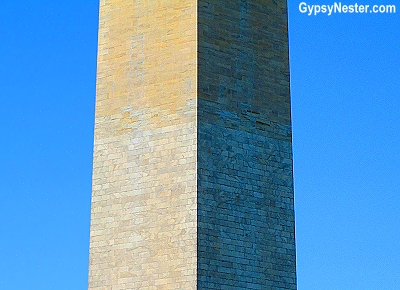
We easily notice the different times of construction by the color of the stones, an obvious change occurs about one third of the way up.
When it was finally completed in 1884 it was the tallest structure in the world, a title held briefly – the Eiffel Tower topped it just five years later.

Our next stop is one of DC’s more overlooked monuments, the Memorial to the Fifty-six Signers of the Declaration of Independence, dedicated in July 1982.
On a small island in Constitution Gardens, an arc of stone blocks depicting each signer’s signature is arraigned in groups by the colonies that they represented. While we are familiar with the names of many of these patriots, especially the contingent from Boston, we are surprised by how many we do not recognize.

See more about The National Mall of DC
Afternoon: Lovin’ Us Some Lincoln

Constitution Gardens is a part of The Mall that runs along the north side of the reflecting pool between the Washington Monument and the Lincoln Memorial, so when we reach the west end we are standing right at the feet of the Great Emancipator.
Yes, we know that as the sixteenth president Abraham Lincoln was not one of our founding fathers, but his stature and his memorial are just too imposing to ignore.

Climbing the steps where Dr. Martin Luther King delivered his I Have a Dream speech, it is hard not to feel that this is the most inspiring monument in our nation’s capital.
Styled after a Greek temple, it has a classic appearance that houses an enormous statue of the President.

The original plan was for a likeness only ten feet high, but that seemed much too small for the surroundings, so the size was doubled.
We heartily agree with that decision, Lincoln should certainly be remembered as larger than life.
See more about the Lincoln Memorial and some wild myths surrounding his statue
Evening: Founders, Forgotten and Famous
Just off The Mall to the south, we continue our ride along the shore of the Tidal Basin in West Potomac Park.
The park is home to memorials for Dr. Martin Luther King and President Franklin Roosevelt.
See more about the King and Roosevelt Monuments
We stop to pay our respects but, in keeping with our founders theme, we are just passing through on our way to a lesser known monument, The George Mason Memorial.

Mason is sometimes called the Forgotten Founder, but his contribution to the constitution should be unforgettable.
Having written the Virginia Declaration of Rights, the state sent him to the Constitutional Convention where he had a major impact. Ironically, he refused to sign the final document, feeling it did not provide the proper protections for individual freedoms.
He lobbied for a Bill of Rights, which was later adopted and closely resembled his earlier Virginia Declaration. Perhaps that is why he looks so content and comfortable on his bench gazing across the water toward The Mall.

From the man behind the Bill of Rights, we go to the author of the Declaration of Independence.
The last of the memorialized founders we will visit is Thomas Jefferson. Another classic design, the Jefferson Memorial is based on the Pantheon in Rome, and Jefferson’s own design of the Rotunda at the University of Virginia.

In the center, a five-ton bronze statue of our third president stands looking past the Washington Monument toward the White House. He is surrounded by excerpts from the Declaration of Independence and quotes from several of his letters.
As we look out over the tidal basin at our nation’s capital with Jefferson, we can’t help but feel that we have found a kinship with the founders on our journey so far.

This excites us for tomorrow’s exploration of the city that effectively served as the first capital of the United States of America, Philadelphia.
Day Five: Philadelphia
Afternoon: Catching up While Rolling Down the Tracks
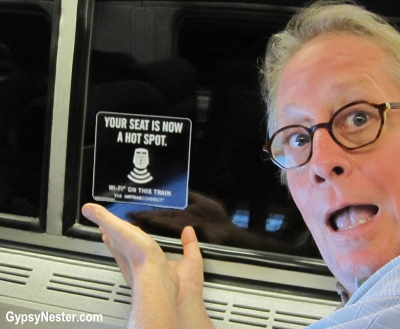
The jump from Union Station, in the center of Washington DC, to downtown Philadelphia takes only two hours by rail.
With free WiFi and in-seat power outlets, we are actually glad to have the time to catch up a bit while rolling down the tracks.

We arrive in the City of Brotherly Love at the 30th Street Station, the main railroad station in Philadelphia.
The old Pennsylvania Railroad opened the Art Deco style terminal in 1933, and now it is Amtrak‘s 3rd-busiest station.

The center point of the main passenger concourse is the Pennsylvania Railroad World War II Memorial honoring Pennsylvania Railroad employees killed in World War II.
The bronze statue of the archangel Michael carrying a soldier is by Walker Hancock, one of the “Monuments Men” who recovered looted art from the Nazis during the war.

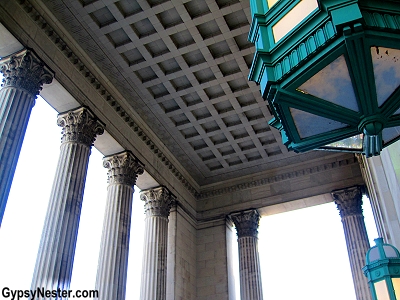
In light of Philadelphia’s unique place in American history, there was a movement to rename the station Ben Franklin Station a few years ago in honor of the famous founder’s 300th birthday.
But due to fears that there would be too much confusion between the names Ben Station and Penn Station, the idea was dropped. Too bad, but there are still plenty of tributes to Mr. Franklin throughout Philly, we might even say it’s all about the Benjamins.
Evening: Eating Like a Patriot

Unlike colonial times, our journey from our current capital city to America’s first capital was anything but arduous, still we are ready for a bit of repose after our travels.
To indulge that notion, and to get fully immersed in the colonial spirit, we decide to hit the City Tavern for dinner.
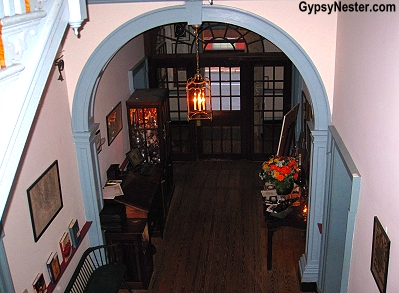
As the seeds of the revolution were sprouting, the City Tavern was certainly at the center of it all.
John Adams called it “the most genteel tavern in America” while visiting Philadelphia for the First Continental Congress, Paul Revere rode here to proclaim the news that the British had closed the port of Boston, and Thomas Jefferson kept an open tab while writing the Declaration of Independence.

The original structure was partially destroyed by a fire, perhaps of suspicious origin according to our server, in 1834, and then demolished in 1854.
But a perfect replica of the historic building was built and re-opened in 1976 for the United States Bicentennial. The new City Tavern is now a part of the Independence National Historical Park.

This is a candlelit tavern and we feel a tankard of ale is in order. Perfect, City Tavern has Ales of the Revolution on tap, brewed with the very recipes used by George Washington, Thomas Jefferson, and Benjamin Franklin. We choose Jefferson’s 1774 Tavern Ale, and Franklin’s Poor Richard’s Tavern Spruce.
Move over Sam Adams, it seems many a founding father knew a thing or two about beer. Cheers!

We are excited to sample truly typical colonial fare, so we ask which menu items are most accurate and learn that owner and executive chef Walter Staib uses many authentic 18th-century recipes.
As a starter, local mushrooms on pan-fried Sally Lunn bread, a traditional yeast bread from England, with a béarnaise sauce certainly fits the bill.

It seems that the pot pies are quite genuine as well, based on Martha Washington’s recipe, so one turkey pie please.
The menu also mentions an intriguing story about Ben Franklin. It seems that he introduced tofu to North America in a 1770 letter to his friend, the renowned botanist John Bartram, so we order that too.

The mushroom toast is fantastic, the crust on the pie light as a feather, and the tofu firm and tasty.
In fact, everything is so delicious that we give the chocolate mousse cake, also handed down from Martha Washington, a try. With one bite we are singing the praises of our forefathers, and mothers, once again.
It is hard for us to imagine that the colonists ate this well, but if the portraits of old Ben accurately portray his paunch, we have reason to believe they did.
Day Six: Philadelphia
Morning: Getting Independent

There are dozens of historic buildings, sites, and museums in Philadelphia, and they are easy to reach from the 5th Street Subway Station, which is just a few stops on the Blue Line from 30th Street Train Station.
The hard part is choosing which ones to see when divvying up our time.

As soon as we step out of the subway we are looking right at Independence Hall.
Truly the birthplace of the republic, this is where both the Declaration of Independence and the Constitution were deliberated and approved. We feel it all around us, inch for inch this is the most historic ground in America.
Built in 1753 to house the colonial legislature of Pennsylvania, it became meeting place for the Second Continental Congress in 1775, then the site of the Constitutional Convention in 1787. Prior to the ratification of the Constitution there was no official United States capital (or capitol!) but Philadelphia, and this building, certainly met all of the criteria.

At first the Constitution named New York City as the capital, but there was much debate as to where a permanent site should be and soon it was returned to Philly.
From 1790 until 1800, Congress met right next door in Congress Hall. The hall was built in 1789 to house the Philadelphia County Court, but quickly became the meeting place for the House of Representatives on the main floor, and the Senate upstairs. This was also the site of two presidential inaugurations, George Washington for his second term, and John Adams.

On the other side of Independence Hall is the Old City Hall, which housed the Supreme Court during Philadelphia’s time as the capital city.
Originally built in 1790 as City Hall, it did double duty until 1800, when the national capital was moved to Washington.

The National Park Service has restored the interior, so inside we find the jury box, witness stand, and judicial bench just as they would have been when statesman and patriot John Jay called the court to order as the first Chief Justice of the United States.
Afternoon: How Freedom Rings

Library Hall is home of the country’s first public library.
We are completely unsurprised to learn that Benjamin Franklin had a hand in founding this in 1731.
Since books were a rarity in those days he invited the members of Congress to use the resources, effectively making it the first Library of Congress.

Inside, there is a copy of the Declaration of Independence in Jefferson’s own handwriting, as well as a first edition of Sir Isaac Newton’s Principia, and a first edition of Charles Darwin’s Origin of Species.
Embedded in the facade is our favorite statue of old Ben that we have seen so far. LOVE the toga.

Directly across the street is The Liberty Bell Center, so we walk over and fall into line with the myriads of excited middle schoolers on their end-of-the-school-year trips.
While we wait, we ponder how some things become so iconic. The bell was in the tower of Independence Hall, but actually played a very small part in history. In fact, the story of it ringing out the news of Independence on July 4, 1776 is most likely false since the declaration wasn’t read in public until July 8. Yet the bell has captured the hearts of Americans for over one hundred and fifty years.

The mis-understanding stems from an 1847 story by George Lippard, printed in the Saturday Review.
He told a tale of an aged bellman waiting by the bell on July 4, 1776, and a young boy who appeared with instructions to ring the bell proclaiming independence.
Within a few years it had been accepted as fact, and soon began to appear in textbooks. But then what is history without a good story or two, and we don’t feel like the symbolism of the bell is diminished.
Let freedom ring!
Evening: Not Everyone was Free

In front of The Liberty Bell Center we investigate a relatively new discovery at The President’s House, which opened in 2010.

While it was known that a house where Presidents Washington and Adams had lived stood on this site until 1832, it wasn’t until 2000, while excavating for the new Liberty Bell Center, that the foundation was uncovered.
When it was discovered that the exposed ruins were of slave quarters, a door was opened for discussion of a topic that had been long avoided, the fact that many of our founding fathers were slave holders. The memorial, President’s House: Freedom and Slavery in the Making of a New Nation, addresses the subject like this:
If we are to understand how a nation founded on the principle that “all men are created equal” could also somehow embrace and justify slavery, we must examine the context and effect of this contradiction on the lives of Americans of every race and condition.

We find the inconsistency hard to reconcile, but can take comfort in the fact that America has steadily moved forward in her efforts to fulfill the founder’s ideals of a free and equal society.
The country they started has always been a work in progress, and our history can, and should, inspire us to keep striving.
Day Seven: Philadelphia
Morning: Back to Ben

Ben walked here: David does his best Franklin impression
Today we begin with our old buddy Ben again at Franklin Court.
A small tunnel leads us into a courtyard where the house that he lived in from 1763 until his death in 1790 once stood.
The structure has been gone for two hundred years, but a “ghost house” showing its location was built for the bicentennial in 1976.

The steel frame outline stands over several viewing portals where remnants of the Franklin home can be seen below ground level.
The house site was excavated by researchers beginning in 1953, and continuing up to just before the bicentennial celebrations. Windows into the excavations show foundations, walls, and even one of Franklin’s privy pits.
We had no idea that we would be getting so personal with one of the founding fathers today!

This was not only where Franklin lived, but also where he worked. He owned all of the buildings surrounding the courtyard, one of which served as a post office, and another as his print shop.
Both are still operating, the post office in its official capacity, and the print shop as a recreation run by the National Park Service.

We walk into the print shop just in time to catch a ranger printing up a copy of The Declaration of Independence as a demonstration for a group of school kids.
The press and type setting are just as they would have been when Franklin was printing newspapers here in revolutionary times.

Mr. Franklin realized that the sharing of information would be essential for the country to unite, so he began mailing newspapers throughout the colonies to keep everyone on the same page, so to speak. Perhaps that is why he opened a post office next door.
The B. Free Franklin Post Office looks much like it would have when Franklin would have used it as the first Postmaster General in 1775. This is the only post office in America that does not fly the stars and stripes. This is a nod to the fact that when it opened this was still British territory so the United States didn’t have a flag yet.
Afternoon: Betsy’s Place

Speaking of flags, the Betsy Ross house is just up the street. While we hate to be bursters of bubbles, this particular site is of dubious historic value at best.
Not only is it widely accepted that the legend of Betsy sewing the first flag is most likely false, there is also serious doubt as to whether she ever even lived in this house.
We figure we’ll move on to something a little less famous, but a lot more authentic, Elfreth’s Alley.

On a tip from a local gentleman, we did a little searching and found the alley on our map, so off we go. What a great tip!
Named after Jeremiah Elfreth, a colonial blacksmith, this is considered the nation’s oldest residential street, and it has been amazingly preserved. A rare surviving glimpse into life on a 18th-century working-class street.
In a weird way it reminds us of Venice – while it looks like a place for tourists, there are real residents living here going about their day-to-day lives. What a cool place to live.
Evening: Banking and Burials
Philadelphia is sometimes called The Cradle of Liberty, or The Birthplace of America, but it could also be called the Home of Federal Banking.

The first United States Mint was built here in 1792, but before that Congress established the First Bank of the United States.
As the first Secretary of the Treasury, Alexander Hamilton felt strongly that a national bank was necessary to stabilize the finances of the fledgling federal government. Though the idea faced serious opposition from anti-federalists led by Thomas Jefferson and James Madison, Congress authorized the bank with a twenty-year charter on February 25, 1791. In 1811, the bill to renew the Bank’s charter failed by one vote, so operations were ceased.

A few years later, the costs involved with the War of 1812 had Congress feeling the need for a federal bank again.
For some reason, instead of reopening the first one, they chartered a new version for another twenty years. So we walk over a couple of blocks to see The Second Bank of the United States. When Andrew Jackson became president, he was opposed to the idea of a national bank and refused to renew the charter again. Now it is an art gallery with a large collection of portraits of prominent early Americans.

On our way between the two banks, we passed Carpenters’ Hall, so we backtrack a bit to see it.
The First Continental Congress met here in September and October of 1774. Later, the hall served as a hospital for both British and American troops during the Revolutionary War. It also has a connection to the First Bank of the United States, the bank rented the first floor as their building was under construction.

Our last stop before heading on to New York City is Benjamin Franklin’s grave.
Though he was originally from Boston, Franklin had such impact on Philadelphia that it is very fitting that his final resting place is here. He is laid to rest with his common-law wife of forty-four years, Deborah, in the Christ Church Burial Ground.
The tomb is covered with pennies, which we learn is a Philadelphia tradition that is supposed to bring the penny-tosser good luck. We certainly feel like we had plenty of luck with our adventures in Philly, even without tossing a penny.
Now on to The Big Apple!
Day Eight: New York City
Morning: Into the Heart of Manhattan

Amtrak‘s Northeast Regional arrives right in the heart of Manhattan, but the grand old depot that was once here has become Madison Square Gardens. That is pretty darn grand too, just in a different way.
But we aren’t here to see the Knicks or the Rangers, we are on the trail of the founders, and thanks to the incredible New York subway system we can get anywhere in the city from right here at Penn Station.
New York City was the first official capital of the United States designated in the Constitution. From March of 1789 to December of 1790, lower Manhattan was the seat of our government. We are off on a quest to find any remaining vestiges of that slice of American history.
Afternoon: Finding the Old in the New


Unfortunately almost all traces of that bygone era have disappeared, buried under the skyscrapers that have risen since that time, but one place that has survived — and thrived — is Fraunces Tavern.
It is said to be the city’s oldest surviving building, and who are we to argue? It served as a meeting place of the Sons of Liberty, was shelled by the British in 1775, and was the site of General George Washington’s farewell address to the officers of the Continental Army at the end of the Revolutionary War.


When the government set up shop in New York, the building housed the Treasury, Foreign Affairs, and War departments.
Later, it served as a hotel, and today it continues as a tavern, offering many 18th century dishes served on long tables with benches, much like it would have been back in Washington’s day.

A few blocks up Broad Street from Fraunces Tavern we find another of the city’s most historic places, Federal Hall.
This was the site of the first capitol building for the United States and where George Washington was inaugurated as the first President. It was also where the United States Bill of Rights was introduced in the First Congress.

Unfortunately, the original building was torn down in 1812. The current structure was built in 1842 as the United States Custom House, in place of the old Federal Hall.
In 1883, a statue of George Washington by John Quincy Adams Ward was erected on the front steps, then in 1939 the location was designated as the Federal Hall Memorial National Historic Site.
By turning our heads we get a perfectly framed view of Trinity Church. While Washington served as president in New York, this was the church he attended.

The current building is not the same, it is actually the third version to occupy the spot and was constructed in 1846. Though the church has changed, the Trinity Churchyard has not.
This is the final resting place of Alexander Hamilton; he was buried here after his fateful duel with Aaron Burr.
As messy as modern day politics can be, at least we haven’t had a vice president kill a secretary of treasury lately.
Evening: Finding Forefather Foundations

With the government based here on Manhattan, the founding fathers had to live nearby so we set out to find a couple of their houses, or at least the places where their houses once existed.
First up, Thomas Jefferson. While he served as Secretary of State Jefferson, he lived at 57 Maiden Lane, just a few blocks from Federal Hall. All that remains to remind us is a plaque at the base of the giant skyscraper that stands on the address today.

But we are shocked to find that Jefferson’s plaque is downright extravagant compared to the one that marks the spot where the first presidental mansion for the good old U. S. of A. once stood.


After looking high and low, peaking through fences and around construction barriers, we finally get a peek at a decrepit old inscription marking the spot of the The Samuel Osgood House, our first “White House.”
Yes, all that is left of the site where The Father of Our Country lived and worked as our first president is a dirty old marker on an abutment of the Brooklyn Bridge.
Seems a shame, so we set out to find something a little more elegant.

Gracie Mansion, on the upper east side, is mostly known as the home for the mayor of New York, but it has a history involving the founding fathers as well.
During the Revolutionary War, General Washington used the previous house that was here as his headquarters. After the war, Archibald Gracie built the current mansion and it was a gathering place for the New York Federalists led by Alexander Hamilton.
Even though much of the city’s colonial past has given way to the concrete jungle, we find New York to be a treasure trove of history, one worth seeing.
David & Veronica, GypsyNester.com
Thanks to Amtrak for providing the train travel portion of this adventure through Boston, Philadelphia, New York, and Washington, DC! As always, all opinions are our own.
This post may contain sponsored links.





Some really marvelous work, absolutely great content.
Thanks Judi!
Thanks, it’s very informative
Thank you for the great article
This post is worth everyone’s attention. How can I find out more?|
*You should take part in a contest for one of the best blogs on the web. I will recommend this site!
What an amazing trip! Your photos brought back many memories of my trip across the country. We didn’t have time to see as much, since we had one day to get from Pennsylvania to Massachusetts by car. We spent most of the morning at Valley Forge. We got to Philadelphia in the afternoon and almost found nowhere to park. We had 45 minutes. Since we had no time to wait in line for a tour of Independence Hall, we saw the Liberty Bell instead.
We waited until we were staying in Massachusetts to see Boston. It would have been more fun had I not had a broken toe. We saw Washington,D.C. on another trip earlier. Since you were traveling by train, you didn’t have to worry about parking.
Thanks for sharing your trip with us. I’ll be sharing it with others.
Thanks Barbara! Very nice of you to share this.
Wow, what a great – and fun! – post. Oddly, I just sort of stumbled across on your blog and the timing is perfect: One of our crew will be visiting DC for the first time next month. This is the perfect primer for that trip! Love the train idea too – what fun! Thanks for sharing and for the great details.
Thanks Rob! Hope you have a great trip!
Enjoying so much reading your adventurous trip on Amtrak, visiting all the historical cities and sites. Pictures are great. Robert and I enjoyed the Boston history tour during the AARP Life@50+ convention, and know we would enjoy an in-depth history trip like this, especially on the train. (Have wonderful memories of taking the train during my youth with my grandmother to Atlanta to visit her sisters and go shopping.) Need to look into traveling on Amtrak from Atlanta to DC. Great seeing you both in Boston. We had great fun there.
Thanks Mary, great to see you too. We had a blast.
Hey, you missed Hampton Roads – Jamestown, Williamsburg, Yorktown, Jamestown Settlement, known as “America’s Historical Triangle,” and all the American Indian History and Plantations one can handle. Also lots of Black American history, Ft. Monroe and the Emancipation Oak at Hampton University, which is also historical.
The other Veronica
We will have to get to those another time. Thanks for the tips! Veronica.
Sorry we missed your visit to Philly. You’ll have to return sometime when we’re back in residence. As you know, there’s lots more to see. We’re at SFO waiting for a flight to Boston—on our way home after 4.5 months away. The Boston stop is to pick up or dog and car.
Sorry we missed you too! It’s been quite a whirlwind trip.
Lori and I took the Crescent City Limited from Hattiesburg, Mississippi to Washington for our 10th anniversary back in 1995. It was our first real experience with train travel (as adults, anyway: we have some very early and vague memories from around age 3), our first overnight train, and it was so hugely memorable! Amtrak is a way underutilized travel resource for most Americans; thanks David & Veronica, for such a great blog!
-Chuck & Lori
Thank you guys! Trains are definitely overlooked.
Great review of D.C.! I’m glad you were able to visit all of those awesome places. The food looked great! Thanks for sharing.
I’ve only ever been to Boston once, and really for only a day on a family trip up to Nova Scotia. I’d love to go back and visit someday and try out that pot roast at Durgin-Park!
Worth the trip. True Yankee pot roast.
Great shots of my old town. Love the idea of the visits via Amtrak – are you doing one of those writer’s residencies with them?
One clarification – nobody from Boston calls it “The Charlie”. We call it “The T”, for the symbol used for it, the T in a circle, and because the agency is the MBTA. A long time ago it was just called the MTA, which is when the song “Charlie on the MTA” became popular.
A little more than a decade ago, when the T finally started using electronic fare cards and tickets instead of metal tokens, they embraced “Charlie” and named the single-ride tickets “Charlie Ticket” and the multi-fare cards “Charlie Cards”. But it’s still “The T”, you just need a Charlie Card to ride it.
Ironic, considering “Charlie on the MTA” was about the unfair fare increases on the T!
Thanks for clearing that up for us Mark – you ROCK! We have fixed the story to reflect the correct information.
I hope to visit Boston one day, I’m bookmarking this article for when I go. Great article and love the photos
Stay tuned Freya! We’ve got another full day tomorrow – lots more history!
I love how Boston’s history is so easily accessible from the T stops. Enjoy your adventure. It was great meeting you in Boston!
Thanks Jen – great meeting you too! We’re BIG Boston fans now, too.
We were just in Boston last weekend for a 48 hour visit! We missed out on the Tea Party museum, though. Would’ve loved to re-enact throwing the tea overboard!
It really is a fun recreation, and we learned a lot too.